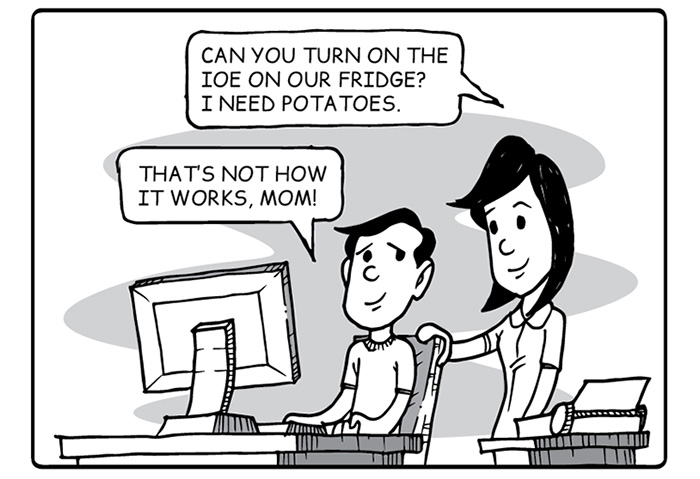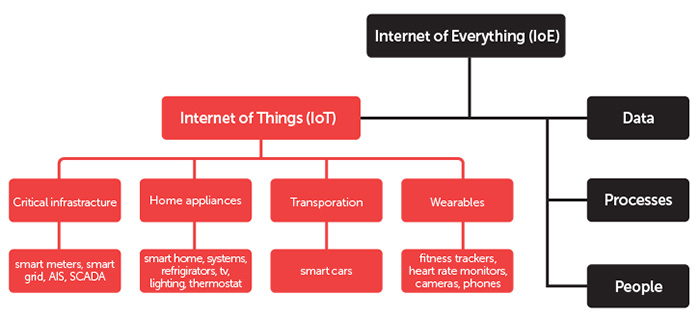IoE 101: How to Explain All Things Smart, Wearable, and IoE

By 2025, the Internet of Things (IoT), which includes wearable technology, would have progressed so fast that no one's going to notice the fitness or tracking features embedded into a sports watch anymore. Why would you when they're going to be everywhere by then? It has been predicted that the number of Internet-connected devices are going to reach 50 billion by 2020.
[Read: What can we expect from the IoE in 2020?]
The IoT falls under the bigger umbrella of the Internet of Everything (IoE), which then includes people, so it seems about right that everyone gets familiar with it. A number of smart home technologies are also coming into the spotlight and people around you are going to want to know more about the IoE. Here’s an easy way for you to explain the whole thing without losing your sanity and patience in the process:
Step 1. Start with a picture
Imagine an intersection where a number of roads meet. In a few words, the IoE is essentially where people, processes, data, and things converge. It's a busy intersection where individual vehicles that represent each of those four factors move in different paths without crashing into each other.
Step 2. Gently slide into the definition
The Internet of Everything (IoE) is a concept that connects people, processes, data, and things through the Internet. With the help of the Internet, these four can easily be programmed to respond and act according to a given situation.
Designed to improve the way cities, industries, and people live today, the IoE involves assigning digital identifiers to everyday objects such as wearable devices and home appliances, giving users new ways to connect, interact, and share. The IoE also holds the potential to be a driving force behind large critical infrastructures across cities and industries.
While it unlocks new possibilities for sharing and connectivity, those who benefit from IoE could also be open to attacks against it. As it grows more popular and more people, processes, data, and devices enter the IoE ecosystem, securing it from potential threats should be a top priority.
Step 3. Differentiate the terms
There are a lot of terms revolving around the IoE megatrend, but here are a few nuanced differences you need to take note of:
- IoE is different from IoT. IoE is the bigger umbrella that encompasses the IoT. The IoT refers to the concept of assigning digital identifiers to everyday objects, allowing inanimate things like wearable devices, home appliances, vehicles, and others to be remotely accessed for ease of use and convenience. The bigger ecosystem of these smart things, when partnered with data, processes, and people then forms the concept of IoE.
- All smart things are part of the IoE. Smart devices, such as mobile phones, help form an intelligent network that can be controlled or accessed online under the IoE umbrella.

Step 4. Give examples of the ways IoE is applied
Remember when Jennifer Parker was greeted by her future home in the movie “Back to the Future”? That is one of the many scenarios that can be realized by the IoE. A variety of smart systems for homes, cities, vehicles, personal fitness, and a lot more already exist. Here are a few notable ones:
- A smart thermostat that intelligently adjusts the temperature
- Door locks that you can control wirelessly over a Bluetooth connection
- Smart light bulbs that can be controlled with a smartphone app
- A wristband that uses your heartbeat to pay for groceries
Step 5. Wrap up by explaining the bigger picture
Smart devices, wearables—all these terms that fall under the IoE umbrella are here to stay. In the years to come, advancements in technology will spread wide enough, with multiple manufacturers, platforms, and software to choose from. Because of this, it will be quite challenging for everyone to ensure that their data is safe while using IoE-enabled devices.
[Read: Security Considerations for Consumers Buying Smart Home Devices]
We predict that the surge in smart device use will attract more attacks on data. Though we will not see widespread IoE/IoT attacks in 2015, we will see whitehack attempts to spot weaknesses in already-available smart devices like smart refrigerators and cameras as well as wearables. Securing the whole IoE environment requires a layered approach where users, vendors, mobile providers, and other stakeholders each contribute to the safety of the data in them.
Like it? Add this infographic to your site:
1. Click on the box below. 2. Press Ctrl+A to select all. 3. Press Ctrl+C to copy. 4. Paste the code into your page (Ctrl+V).
Image will appear the same size as you see above.
- Unveiling AI Agent Vulnerabilities Part I: Introduction to AI Agent Vulnerabilities
- The Ever-Evolving Threat of the Russian-Speaking Cybercriminal Underground
- From Registries to Private Networks: Threat Scenarios Putting Organizations in Jeopardy
- Trend 2025 Cyber Risk Report
- The Future of Social Engineering
 Cellular IoT Vulnerabilities: Another Door to Cellular Networks
Cellular IoT Vulnerabilities: Another Door to Cellular Networks AI in the Crosshairs: Understanding and Detecting Attacks on AWS AI Services with Trend Vision One™
AI in the Crosshairs: Understanding and Detecting Attacks on AWS AI Services with Trend Vision One™ Trend 2025 Cyber Risk Report
Trend 2025 Cyber Risk Report CES 2025: A Comprehensive Look at AI Digital Assistants and Their Security Risks
CES 2025: A Comprehensive Look at AI Digital Assistants and Their Security Risks